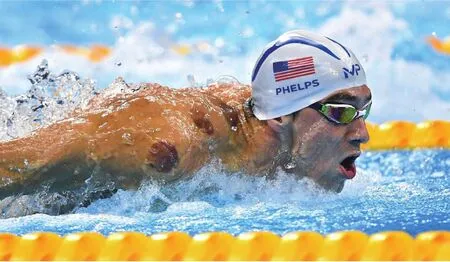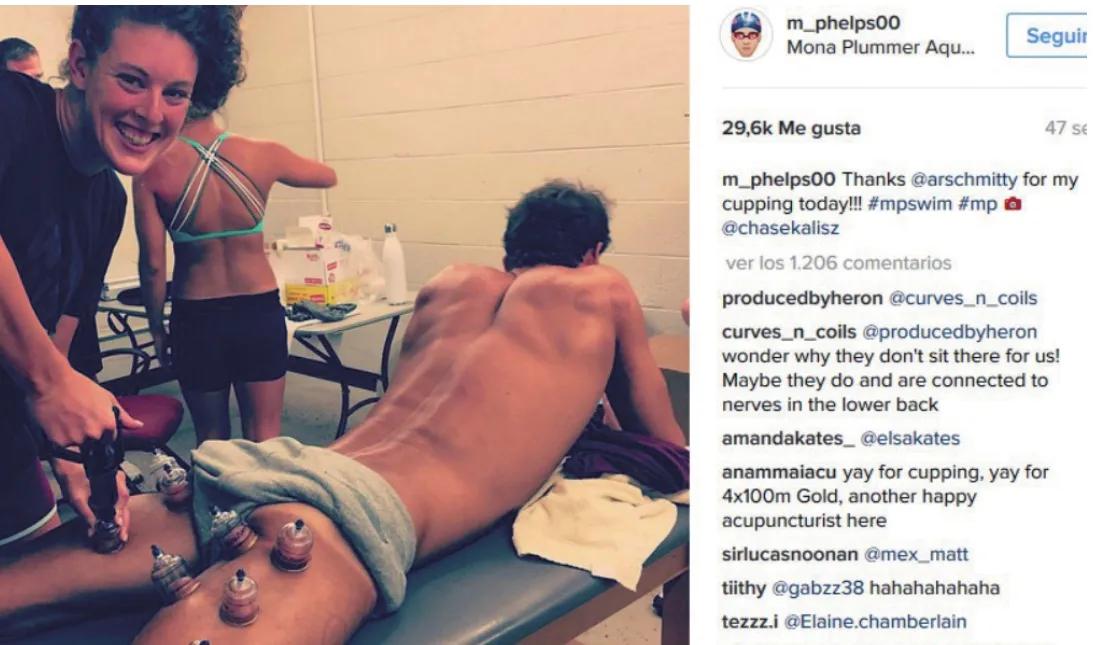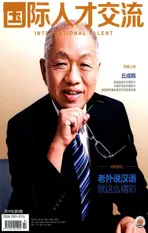“拔火罐”风靡里约奥运会
2016-12-02ChinaDaily
“拔火罐”风靡里约奥运会
Cupping for Glory

在里约奥运会上,泳坛健将迈克尔·菲尔普斯身上的拔火罐印记吸引了全世界的目光
8月8日,当泳坛巨星迈克尔·菲尔普斯在里约奥运会男子4x100米自由泳接力比赛中获得了他的第19枚奥运金牌时,引起人们关注的不仅是他史无前例的金牌总数,还有在他肩背部的神秘红色圆点。
When swimming superstar Michael Phelps won his 19th Olympic gold medal on Aug 8 with the US’ victory in the 4x100-meter freestyle relay, what caught people’s attention wasn’t only his unprecedented number of wins, but also the strange red circles on his back and shoulders.
这些圆形印记对于我们中国人来说却并不神秘——它们是“火罐”疗法留下的印记。(在中国)人人都会拔火罐——每当受凉或是肌肉酸痛时,我们的邻居、父母甚至是我们自己总会尝试“火罐”疗法。
These circles are no mystery to us in China – they are marks left over from cupping therapy. People do it all the time – our neighbors do it, our parents do it and we might try it from time to time when we havea cold or sore muscles.

迈克尔·菲尔普斯在个人社交平台上晒出自己接受拔火罐治疗的照片
但很显然,西方人对这些印记感到十分困惑。《芝加哥论坛报》以开玩笑的口吻对这些印记做了如下四种猜测:1)某种尼古丁形成的斑;2)十分无聊的文身;3)极其精确的吻痕;4)用于更新这台水上运动夺金机器内部软件的端口。而一些人甚至还担心这是感染寨卡病毒的症状。
西方媒体也在大肆报道“火罐”疗法,比如英国广播公司的标题“为什么这么多奥林匹克运动员身上有这些红色圆形印记?”以及《每日邮报》的“美国队疯狂地迷恋一种叫“拔罐”的古老疗法”。
一时间,人们对于“火罐”疗法的兴趣激增。大家都在好奇这是否真的有效以及它是如何起作用的。
美国体操运动员亚历克斯·纳道尔认为这种疗法就像是一种魔法。“这就是我今年能够保持健康的秘密,它比我花在任何其他事情上的钱都来得有效,”他告诉《今日美国》,“它从各种病痛中拯救了我。”
至于“火罐”疗法的原理,美国演员格温妮丝·帕特洛对它做出了很好的解释。她是媒体报道中提到的众多“拔罐”疗法的粉丝之一,其他还有詹妮弗·安妮斯顿、维多利亚·贝克汉姆和嘎嘎小姐等。
“它促进了那部分区域的血液循环,清洁身体内的能量并且排出毒素,”她告诉《芝加哥论坛报》,“虽然看起来很痛,但事实上这种感觉棒极了,让人十分放松。”
但是媒体依然对这种疗法持怀疑态度,称目前并没有科学依据来证明其有效性。尽管如此,英国《卫报》编辑凯特·卡特认为奥林匹克运动员们愿意尝试这一疗法是可以理解的,因为大多数奥运会夺冠都是分毫之争,而这也意味着任何能够提高比赛成绩的方法,无论多么微不足道,都是有益的。
“就把拔罐当成一种反科学的形式吧,”卡特写道,“毕竟,大多数运动员都有自己的仪式和迷信——要是毕生的金牌梦实现的过程仅在数分钟内,你也会尝试能做到的任何方法,并且在那之后感觉好多了。”(ChinaDaily供稿)
But apparently the Westerners are deeply puzzled by the marks. As a joke, The Chicago Tribune made four wild guesses of what they might be: “a) *nicotine patches of some sort; b) very *bland tattoos; c) extraordinarily precise *hickeys; d) ports used to feed software updates to this gold-medal-winning *aquatic machine.” Some people even fear that they might be a symptom of the Zika virus.
Western media also couldn’t stop reporting about it, with headlines like the BBC’s “Why are so many Olympians covered in large red circles?”and Daily Mail’s “Team USA go crazy for ancient healing technique called cupping”.
All of a sudden, interest in cupping therapy has spiked. People are wondering whether it actually works and how it works.
According to American gymnast Alex Naddour, the therapy works like a magic trick. “That’s been the secret that I have had through this year that keeps me healthy. It’s been better than any money I’ve spent on anything else,” he told USA Today, “It has saved me from a lot of pain.”As for how it works, American actress Gwyneth Paltrow – one of the reported celebrity fans of cupping, in addition to Jennifer Aniston, Victoria Beckham and Lady Gaga – explained it pretty well.
“It gets the blood circulating back through whichever point that is and to, you know, clear the energy and get the *toxins out,” she told The Chicago Tribune, “It looks painful, but actually it feels amazing and it’s very relaxing.”
But the media are still quite skeptical about the therapy, saying there is no scientific evidence to prove its effectiveness. Even so, The Guardian’s editor Kate Carter thinks it’s understandable that Olympians are willing to try it because most Olympic wins are “marginal”, which means any method that could improve performance, however small, is helpful.“Think of cupping as the anti-science version,” wrote Carter, “After all, most athletes have their own rituals and superstitions – and if a lifetime of dreaming of gold came down to a few minutes of your life, you would take every edge you can get too, and feel all the better for it.”
